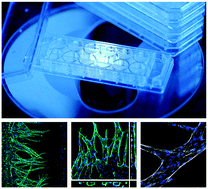Our official English website, www.x-mol.net, welcomes your feedback! (Note: you will need to create a separate account there.)
Microfluidics within a well: an injection-molded plastic array 3D culture platform†
Lab on a Chip ( IF 6.1 ) Pub Date : 2018-07-02 00:00:00 , DOI: 10.1039/c8lc00336j Younggyun Lee 1, 2, 3, 4 , Jin Woo Choi 2, 3, 4, 5 , James Yu 2, 3, 4, 6 , Dohyun Park 1, 2, 3, 4 , Jungmin Ha 1, 2, 3, 4 , Kyungmin Son 1, 2, 3, 4 , Somin Lee 2, 3, 4, 6 , Minhwan Chung 2, 3, 4, 5, 7 , Ho-Young Kim 2, 3, 4, 5, 7 , Noo Li Jeon 1, 2, 3, 4, 5
Lab on a Chip ( IF 6.1 ) Pub Date : 2018-07-02 00:00:00 , DOI: 10.1039/c8lc00336j Younggyun Lee 1, 2, 3, 4 , Jin Woo Choi 2, 3, 4, 5 , James Yu 2, 3, 4, 6 , Dohyun Park 1, 2, 3, 4 , Jungmin Ha 1, 2, 3, 4 , Kyungmin Son 1, 2, 3, 4 , Somin Lee 2, 3, 4, 6 , Minhwan Chung 2, 3, 4, 5, 7 , Ho-Young Kim 2, 3, 4, 5, 7 , Noo Li Jeon 1, 2, 3, 4, 5
Affiliation

|
Polydimethylsiloxane (PDMS) has been widely used in fabricating microfluidic devices for prototyping and proof-of-concept experiments. Due to several material limitations, PDMS has not been widely adopted for commercial applications that require large-scale production. This paper describes a novel injection-molded plastic array 3D culture (IMPACT) platform that incorporates a microfluidic design to integrate patterned 3D cell cultures within a single 96-well (diameter = 9 mm) plate. Cell containing gels can be sequentially patterned by capillary-guided flow along the corner and narrow gaps designed within the 96-well form factor. Compared to PDMS-based hydrophobic burst valve designs, this work utilizes hydrophilic liquid guides to obtain rapid and reproducible patterned gels for co-cultures. When a liquid droplet (i.e. cell containing fibrin or collagen gel) is placed on a corner, spontaneous patterning is achieved within 1 second. Optimal dimensionless parameters required for successful capillary loading have been determined. To demonstrate the utility of the platform for 3D co-culture, angiogenesis experiments were performed by patterning HUVEC (human umbilical endothelial cells) and LF (lung fibroblasts) embedded in 3D fibrin gels. The angiogenic sprouts (with open lumen tip cells expressing junctional proteins) are comparable to those observed in PDMS based devices. The IMPACT device has the potential to provide a robust high-throughput experimental platform for vascularized microphysiological systems.
中文翻译:

孔中的微流体:注模塑料阵列3D培养平台†
聚二甲基硅氧烷(PDMS)已被广泛用于制造用于原型设计和概念验证实验的微流控设备。由于多种材料限制,PDMS尚未广泛用于需要大规模生产的商业应用。本文介绍了一种新型的注塑成型塑料阵列3D培养(IMPACT)平台,该平台结合了微流体设计,可将图案化的3D细胞培养整合在单个96孔(直径= 9 mm)板上。包含细胞的凝胶可以通过沿角的毛细管引导流和96孔形状因子内设计的窄间隙依次进行图案化。与基于PDMS的疏水性爆破阀设计相比,这项工作利用亲水性液体导管来获得用于共培养的快速且可重现的图案化凝胶。当液滴(即将含有纤维蛋白或胶原蛋白凝胶的细胞放置在一个角上,在1秒钟内实现自发图案化。已确定成功毛细管加载所需的最佳无量纲参数。为了证明该平台可用于3D共培养,通过对嵌入3D纤维蛋白凝胶的HUVEC(人脐静脉内皮细胞)和LF(肺成纤维细胞)进行图案化来进行血管生成实验。与基于PDMS的设备中观察到的相比,其血管新生芽(具有表达连接蛋白的开放腔尖端细胞)具有可比性。IMPACT设备具有为血管化微生理系统提供强大的高通量实验平台的潜力。
更新日期:2018-07-02
中文翻译:

孔中的微流体:注模塑料阵列3D培养平台†
聚二甲基硅氧烷(PDMS)已被广泛用于制造用于原型设计和概念验证实验的微流控设备。由于多种材料限制,PDMS尚未广泛用于需要大规模生产的商业应用。本文介绍了一种新型的注塑成型塑料阵列3D培养(IMPACT)平台,该平台结合了微流体设计,可将图案化的3D细胞培养整合在单个96孔(直径= 9 mm)板上。包含细胞的凝胶可以通过沿角的毛细管引导流和96孔形状因子内设计的窄间隙依次进行图案化。与基于PDMS的疏水性爆破阀设计相比,这项工作利用亲水性液体导管来获得用于共培养的快速且可重现的图案化凝胶。当液滴(即将含有纤维蛋白或胶原蛋白凝胶的细胞放置在一个角上,在1秒钟内实现自发图案化。已确定成功毛细管加载所需的最佳无量纲参数。为了证明该平台可用于3D共培养,通过对嵌入3D纤维蛋白凝胶的HUVEC(人脐静脉内皮细胞)和LF(肺成纤维细胞)进行图案化来进行血管生成实验。与基于PDMS的设备中观察到的相比,其血管新生芽(具有表达连接蛋白的开放腔尖端细胞)具有可比性。IMPACT设备具有为血管化微生理系统提供强大的高通量实验平台的潜力。



























 京公网安备 11010802027423号
京公网安备 11010802027423号